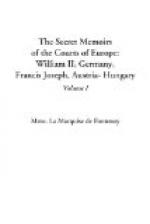It was shortly after this slight inflicted by the emperor on Professor Wallot, and the honor conferred upon Madame Parlaghy, that the National Society of Architects and the National Association of Artists, the two principal organizations of the kind in Germany—composed of all that is most eminent in the realms of architecture and art—jointly invited Professor Wallot to a great banquet in Berlin, at which over six hundred guests were present, in the course of which William was guyed in a most merciless manner! The chief ornament on the principal table was a model of the Reichshaus in “Schwarzbrod,” cheese and confectionery. The dome consisted of a Dutch cheese, the “Germania” on the top was represented by a smartly aproned chambermaid on horseback, the horse being led by a footman in imperial livery, while the whole was labeled “Der gipfel des geschmack,”—the acme of taste. Another item of the programme was a sort of automatic machine, which, when a gold medal was placed in the slot, would perform “Der gesang an Ihr,”—the song to her—meaning, of course, Madame Parlaghy.
The joke, I need hardly say, consisted in the parodying of the title of the emperor’s musical composition “Sang am Aegir!” The lustre hanging from the ceiling, which is known in Germany as a “Kronleuchter” was in the form of an old crinoline. At the entrance to the banqueting hall hung the representation of a gold medal, which a lady painter was trying in vain to grasp. The tone of the speeches throughout the evening was in thorough keeping with the decorations, and it is doubtful whether such a bold exhibition of independence, and even disloyalty towards the sovereign, has ever been seen in the Prussian capital. It speaks well for William’s good sense that he should have refrained from proceeding against any of the organizers of the entertainment on the ground of lese majeste.
There is, as I stated above, one Prussian painter, however, of whom the kaiser is exceedingly fond, whose eminence in art is acknowledged, not only in Germany, but all the world over, and upon whom William has lavished the highest honors that it is in his power to bestow. The painter in question is Professor von Menzel; popularly known in Berlin as “His Little Excellency,” owing to his diminutive size, his stature being about four feet nine inches! Professor Menzel, who is of the most humble origin, is to-day a Knight of the Order of the Black Eagle, which is the Prussian equivalent of the English Order of the Garter, or of the Austrian Order of the Golden Fleece, this decoration carrying with it a patent of hereditary nobility. He is now considerably over eighty, but from his twelfth year he has earned his living by means of his brush and palette. All his principal paintings are devoted to the illustration of historic episodes of Prussian history and of the reigning house of Hohenzollern. One of his masterpieces is entitled “The Flute Concert,” and represents Frederick the Great in his palace at Sans-Souci, at a concert with the principal members of court and his household around him.




